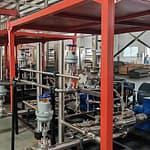Ethylene Oxide Sterilization
Ethylene oxide gas is an agent in the sterilization of medical devices due to its effectiveness and compatibility with most materials. ETO is a colorless gas that is flammable and explosive. The four essential parameters (operational ranges) are: gas concentration (450 to 1200 mg/l); temperature (37 to 63°C); relative humidity (40 to 80%)(water molecules carry ETO to reactive sites); and exposure time (1 to 6 hours).

Of all the alternative sterilization methods available, it is ethylene oxide (EtO) sterilization that arouses most concern. EtO, whether used on its own or mixed with CFCs, has potentially harmful effects both to the environment and the body. However, with adequate attention to the standards that will control EtO sterilization, its future should be relatively certain for a good few years to come.

Ethylene Oxide Sterilization
Although ethylene oxide sterilization (EtO) is commonly used in the manufacture of sterile medical devices, concern about residues of the sterilant in the sterilized products has led to an increase in the use of alternative methods; however, these methods, in turn, have significant drawbacks. The authors have tackled the issue by looking into the possibility of reducing EtO residuals. After conducting a series of investigative experiments, it has been proved that EtO residuals may be reduced by decreasing the amount of EtO used in the sterilization process. This can be achieved without lowering the safe sterility level and there are additional benefits for safety, cost, and the environment.










No comment